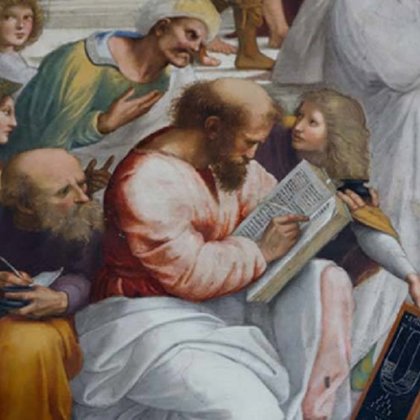PYTHAGORAS (570 BCE – 495 BCE) WAS PRE - SOCRATIC GREEK PHILOSOPHER,PYTHAGORAS IS SOMEONE KNOWN FAR MORE THAN HIS THEORIES AND IDEAS IN MATHEMATICS THAN IN PHILOSOPHY.PYTHAGORAS WAS TREATED LIKE A GOD.HE GAVE SPEECHES BEHIND A CURTAIN.
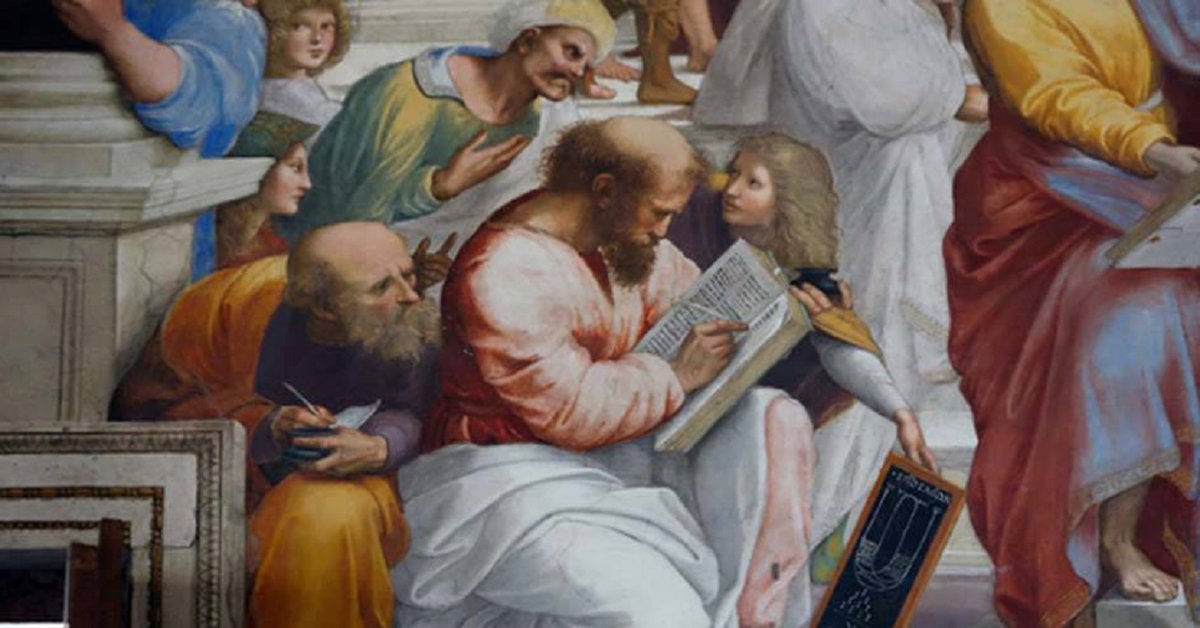 The
School of Athens detail from the left hand side showing Pythagoras
surrounded by students and Michelangelo.The Greek polymath Pythagoras
(c. 570–c. 495 BC) ignited the golden age of mathematics with the
development of numerical logic and the discovery of his namesake theorem
of geometry, which furnished the world’s first foothold toward the
notion of scientific proof and has been etched into the mind of every
schoolchild in the millennia since. His ideas went on to influence
Plato, Copernicus, Descartes, Kepler, Newton, and Einstein, and the
school he founded made the then-radical decision to welcome women as
members.
The
School of Athens detail from the left hand side showing Pythagoras
surrounded by students and Michelangelo.The Greek polymath Pythagoras
(c. 570–c. 495 BC) ignited the golden age of mathematics with the
development of numerical logic and the discovery of his namesake theorem
of geometry, which furnished the world’s first foothold toward the
notion of scientific proof and has been etched into the mind of every
schoolchild in the millennia since. His ideas went on to influence
Plato, Copernicus, Descartes, Kepler, Newton, and Einstein, and the
school he founded made the then-radical decision to welcome women as
members.
Pythagoras was an Ancient Greek mathematician and
philosopher.He was on the Greek island of Samos around 570 BC and died
in Greece probably around 495 BC.In 530 BC he moved to Italy and
established a religious group known as the Pythagoreans. The group was
very secretive and were vegetarians who worshipped the God Apollo. They
didn’t own any possessions.He is best known for the Pythagorean theory
named after him. Often referred to as Pythagoras’ Rule, Pythagoras’
Theorem states that in a right-angled triangle, the square on the
hypotenuse is equal to the sum of the squares on the other two sides.He
believed that science and religion were connected. He also believed that
the human soul returned over and over again into people, animals and
even vegetables.Pythagoras believed that he had already lived four
lives, all of which he could remember. Others claimed that he was able
to travel through space and time and could talk to plants and
animals.Pythagoras believed the Earth was round and that mathematics
could explain the physical world. He also devised the triangular figure
of 4 rows, adding up to 10 and believed the design to be sacred.A
special type of cup is credited to Pythagoras. The cup works normally
when the user sips from it, although the contents are spilled if the
user drinks too quickly.Pythagoras may have had a condition known as
synesthesia. A person with the condition is said to be able to hear
colours and see music, or associate smells with people’s names.No books
or writings by Pythagoras have survived. He probably taught by speaking
to his followers, although in the centuries after his death, several
forgeries were discovered.The philosopher Plato was influenced by
Pythagoras, and thought that mathematics affected philosophy. Pythagoras
also influenced the establishment of the Freemasons and other secret
societies.Pythagoras, the man behind the Pythagorean theorem was more
than just a mathematician. He was a spiritual leader with followers who
thought he’d been sent from Heaven. For the Pythagoreans, math was a
religious experience and some equations were divine secrets, unfit for
public eyes.When your middle school teacher showed you how to find the
hypotenuse of a right triangle, you probably didn’t get down on your
knees and start worshiping him as a god. But when it first happened in
ancient Greece, that was pretty much how people reacted.There was a
whole cult behind the man who figured out how to measure the side of a
triangle, and—as you might imagine—they had some pretty strange
beliefs. Pythagoras
had followers. A whole group of mathematicians signed up to be his
pupils, to learn everything he knew, and to help him solve the great
riddles of the universe. But this was more than just a group of people
who liked math—it was a full-blown religion.Numbers,
Pythagoras believed, were the elements behind the entire universe. He
taught his followers that the world was controlled by mathematical
harmonies that made up every part of reality. More than that, though,
these numbers were sacred almost like gods.The Pythagoreans had sacred
numbers. Seven was the number of wisdom, 8 was the number of justice,
and 10 was the most sacred number of all. Every part of math was holy.
When they solved a new mathematical theorem, they would give thanks to
the gods by sacrificing an ox.The Greeks thought it was a little freaky.
They didn’t just call it a philosophy or a religion they saw it as a
cult and a dangerous one at that. Pythagoras scared people. They even
burned down his house and chased him out of town, fearing his mystic
command over the sacredness of numbers.The Pythagoreans had a sacred
symbol called the Tetractys. It was a triangle with 10 points across
four rows, meant to symbolize the organization of space and the
universe. Ten, they believed, was the number of the highest order, which
contained the course of all mortal things. And they literally worshiped
it.Pythagoras’s followers had a set prayer they used to worship the
number 10. “Bless us, divine number, thou who generated gods and men!”
they would say. “For the divine number begins with the profound, pure
unity until it comes to the holy four; then it begets the mother of all,
the all-comprising, all-bounding, the firstborn, the never-swerving,
the never-tiring holy ten, the keyholder of all.”Everyone had to do it.
If you wanted to join the Pythagoreans, you had to swear an oath to the
holy triangle. They would swear their loyalty “by that pure, holy,
four-lettered name on high,” meaning the Tetractys. Then they would have
to swear by Pythagoras himself, who, like a mathematical Prometheus,
“to our mortal race did bring the Tetractys. Pythagoras’s
followers really believed that he was a demigod. They called him “the
divine Pythagoras” and told people that he was the son of a god—usually
either Hermes or Apollo, depending on whom you asked.They
even had hymns to Pythagoras’s divinity. “Pythais, fairest of the Samian
tribe,” one song went, “Bore from th’ embraces of the God of Day.
Renown’d Pythagoras, the friend of Jove!”They even thought that
Pythagoras had superpowers. His followers said that he could tame eagles
and bears by stroking them. He could control any animal, for that
matter, with the sheer power of his voice, and he had the power to write
words on the face of the Moon.One of the biggest legends about him was
that he had a golden thigh. When someone doubted his divinity, it was
said that Pythagoras would show them his shimmering thigh and win a new
convert. In one story, he showed a priest his thigh and, as a reward,
was given a magical golden dart that let him fly over mountains, expel
diseases, and calm storms.
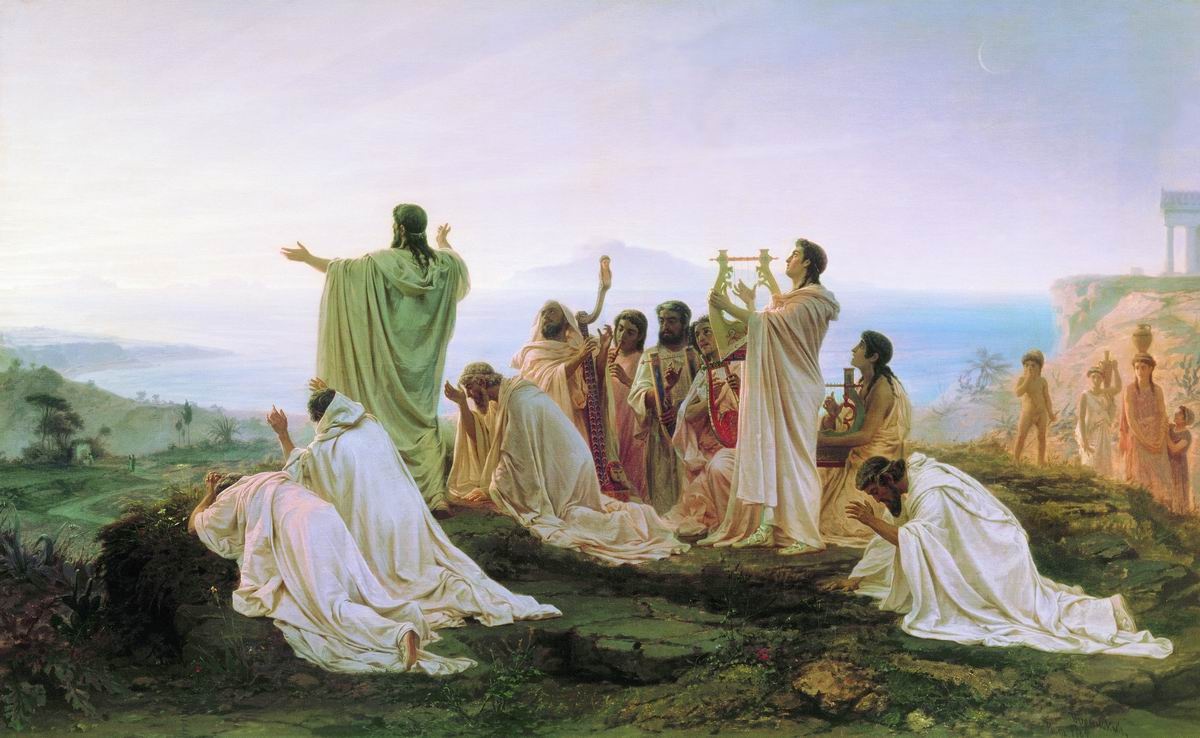
Pythagoreans' Hymn to the Rising Sun,The Golden Verses of Pythagoras (Greek: Χρύσεα Ἔπη, Chrysea Epê; Latin: Aurea Carmina) are a collection of moral exhortations. They comprise 71 lines written in dactylic hexameter verse and are traditionally attributed to Pythagoras.The exact origins of the Golden Verses are unknown and there are varying opinions regarding their dating. It appears that the verses may have been known as early as the third century BCE[2] but their existence as we know them cannot be confirmed prior to the fifth century CE.
Like philosophy, the sciences of math can change anything in the
lives of people directly involved with it. It can absorb one into the
mysterious world of numbers and the endless universe of philosophical
ideas. Pythagoras not only left behind distinctive works, but also
mysterious myths of his personality.Pythagoras was already well-known in his hometown Samos for his
special talent in math. He gained the respect of his teachers and of the
elders thanks to his eloquence, his directness in expressing his
innovative ideas and his extroversion.
Thales, his teacher, was almost exclusively engaged in teaching math to
his best student, Pythagoras.After teaching him everything he possibly
could, Thales encouraged
his student to travel to Egypt and get advice from priests that would
make him “the most divine and the wisest of all men.” Pythagoras ended
up leaving his hometown at the age of 18, because of the tyrannical
regime that suppressed his ideas and the enrichment of his knowledge.His
lifelong journey turned his good relations with religion into
adoration and released his great love towards astronomy and geometry
through his talent in math. The Egyptian priests were skeptical of him,
so they introduced him to their stricter way of life, religion and
learning. All doubts were lost though, as Pythagoras’ passion for
learning and wit was recognized.When he returned to Samos, he funded a school in order to impart
knowledge to his countrymen, but due to their lack of interest, he moved
to Southern Italy in order to find new and more cooperative students.
At the same time, he funded a mysticist,
political and religious fraternity which caused quite a stir, but there
is no further information available on this.His mysterious personality
was noticeable during his teaching; no
notes and questions were allowed, that is why a great part of his works
are lost. There is no additional information even on the renowned
Pythagorean Theorem.It is also not known if Pythagoras invented this
theorem on his own
or with the help of his students. The simple phrase saying that “the
square of the hypotenuse (the side opposite the right angle) is equal to
the sum of the squares of the other two sides” was proven right before
the Babylonians.Even if his school was one of the most famous of his
era, Pythagoras
still had many enemies because of his political and religious actions.
As a result, his school was destroyed by his opponents, prompting his
move to Italy.He spent the last years of his life teaching and
traveling. His fame
however, still created problems. Nonetheless, no matter how much doubt
he was confronted with, nobody can deny his great contribution to
philosophy and math.It
wasn’t that people just got so swept up in the hypotenuse-finding craze
that they started making up stories about Pythagoras—he encouraged
them. Pythagoras directly told people that he was the son of a god and
that he had been repeatedly reincarnated until he reached his current
form.In a past life, Pythagoras claimed, he was the son of Hermes, who
had offered Pythagoras any gift he wanted except for immortality.
Pythagoras asked to retain his memories through each life and now could
remember every person he had ever been. He had fought with Achilles in
the Trojan War. He had worked as a humble fisherman. He had even been a
beautiful courtesan who slept with powerful men.More than that, though,
Pythagoras claimed that he could sense old souls in new bodies. Legend
has it that he once saw a dog getting beaten on the streets and ran in
the way to stop the blows. “Stop! Don’t beat it!” Pythagoras yelled. “It
is the soul of a friend.” He had recognized its voice in the dog’s
barking.Pythagoras was one of the first people in Western
history to abstain from eating meat for moral reasons. Eating the dead,
he taught his followers, polluted the body—and so they must never kill a
living thing.His rules were a bit weird, though. You might remember
that we mentioned earlier his sacrifice of oxen—and, yes, he did both.
Like a vegan who eats fish and chicken, Pythagorean vegetarianism had
some weird loopholes.The offerings he made were always inanimate,” the
Greek writer Diogenes wrote in a biography of Pythagoras. Then Diogenes
clarified: “Though some say that he would offer cocks, sucking goats,
and porkers.” Still, Pythagoras drew the line somewhere. “But lambs,”
Diogenes explained, “Never!”Pythagoras’s rules seemed every bit as weird
to the Greeks as they do to us. During his time, the Greeks spread a
joke about a Pythagorean who insisted that he never ate any living
thing. After getting caught eating dog meat, the Pythagorean said, “Yes,
but [I kill] them first, and so they are still not alive.The
Pythagoreans might have had loopholes for meat, but that didn’t mean
they could do whatever they wanted. Pythagoras had some incredibly
strict and specific rules for just about everything—including which shoe
to put on first.One must put the right shoe on first,” Pythagoras told
his followers. And once your shoes were on, he said, “One must not
travel on public roads.” He didn’t stop at footwear, though. Pythagoras
weighed in on the five-second rule for food that falls on the floor,
telling his followers never to “taste ye of what falls beneath the
board.He was exceptionally strict about sex. Bodily fluids, Pythagoras
seems to have believed, were part of a man’s soul. When a man expelled
them, he gave up some of his strength. Pythagoras’s followers were
taught to abstain from sex whenever possible. But if they couldn’t help
themselves, he told them: “Keep to the winter for sexual pleasures, in
summer, abstain. Silence,
Pythagoras believed, was very important. Staying quiet was a way to
learn self-control, and so he made sure that anyone who wanted to join
his cult could do it. Anyone who signed up had to close his mouth and
keep it shut for five years straight.In part, this was to
help people stay pure. But there’s a lot of reason to believe that it
had more to do with making sure they could keep secrets. Even in ancient
Greece, calling yourself the son of god and getting people to worship
numbers wasn’t exactly considered being a model citizen.The Pythagoreans
tried to keep that part of their lives quiet. As a result, they
wouldn’t let anyone into the fold unless the person proved that he could
keep his mouth shut.
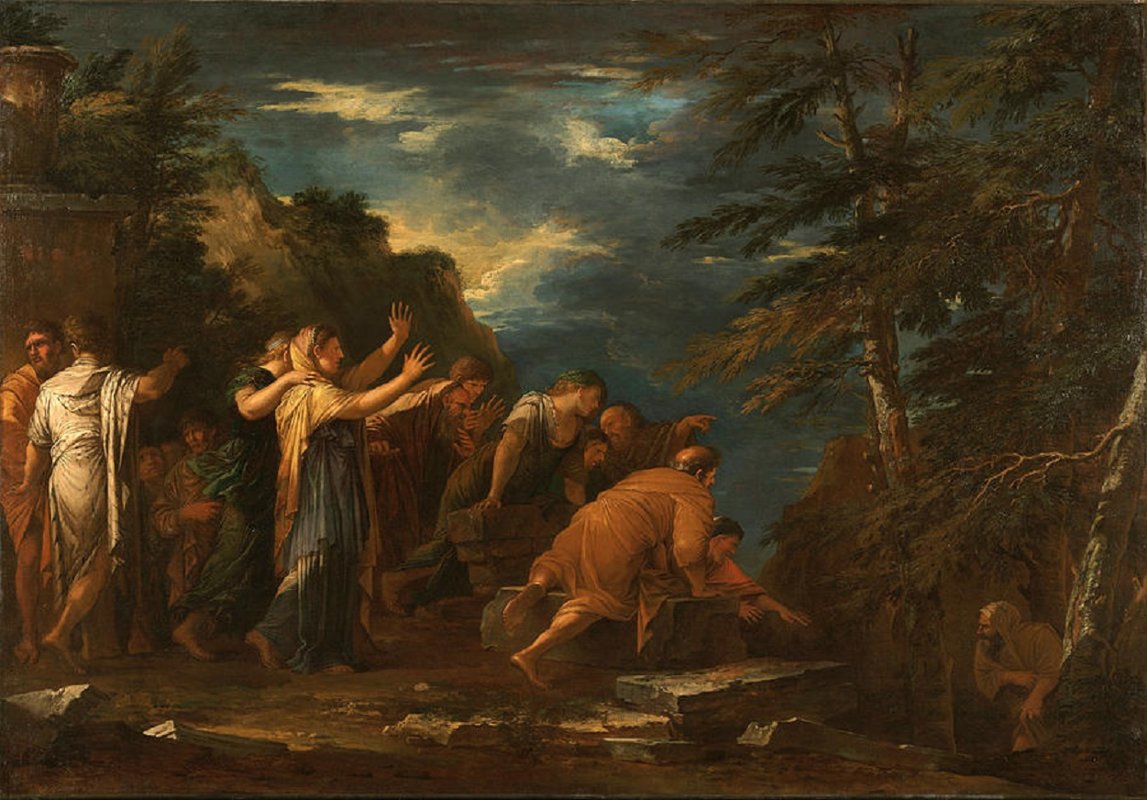 Rosa
Pythagoras Emerging from the Underworld .It looks familiar enough in
many ways, with the disciples greeting the man emerging from the tomb,
and especially the fervent women rejoicing. (See it in more detail
here). Except it is very much not what we think. The man returning from
the dead is not Christ but Pythagoras, the genius and reputed
miracle-worker who lived in the sixth century BC.Remembered today as a
philosopher and mathematician, Pythagoras was a mystic who believed in
immortality and the reincarnation of the soul. He mocked the official
religious teachings of his day, and one story recounts that he visited
the underworld during his lifetime.
Rosa
Pythagoras Emerging from the Underworld .It looks familiar enough in
many ways, with the disciples greeting the man emerging from the tomb,
and especially the fervent women rejoicing. (See it in more detail
here). Except it is very much not what we think. The man returning from
the dead is not Christ but Pythagoras, the genius and reputed
miracle-worker who lived in the sixth century BC.Remembered today as a
philosopher and mathematician, Pythagoras was a mystic who believed in
immortality and the reincarnation of the soul. He mocked the official
religious teachings of his day, and one story recounts that he visited
the underworld during his lifetime.
Most of the Greeks,
though, didn’t understand the dark implications of these silent
acolytes. The Greeks were just happy that a Pythagorean wasn’t going on
about numbers for a change. Generally, people were more impressed by the
quiet ones than the people who were allowed to talk.One of Pythagoras’s
most famous followers was Hippasus. Legend has it that he was the first
person to prove the existence of an irrational number—and he may have
died for it.Hippasus developed a proof that showed that the square root
of two was an irrational, never-ending number. This was more than just a
major discovery—it was open rebellion. Pythagoras had taught that all
numbers could be expressed as ratios of integers, and Hippasus had
proven his divine teacher wrong.According to the legend, Hippasus showed
his proof to Pythagoras while they were on a boat. In response,
Pythagoras grabbed Hippasus, wrestled him to the side of the boat, and
held his head underwater until he stopped moving. Then Pythagoras threw
the lifeless body overboard, turned to the others aboard, and warned
them never to tell a soul what had happened.That story is probably not
true. It seems to be a twisted version of a Pythagorean fable that said
Hippasus was drowned by the gods as punishment for disclosing the secret
of irrational numbers to the world.But that story still reveals
something creepy about the Pythagorean cult. They spread this story,
it’s believed, as a parable—a warning telling their followers that if
they shared the cult’s secrets with the world, they could expect a
watery grave.There were two types of Pythagoreans: the akousmatikoi and
the mathematikoi. The mathematikoi were Pythagoras’s closest and most
trusted followers. He would meet with them in person and explain his
theorems to them in detail. They were allowed to know the secrets of
advanced math that were kept hidden from the rest of the world.They had
to pay a heavy price for the privilege. To become a mathematikoi, a
person had to give up meat, women, and all private possessions. From
then on, their only loyalty was to Pythagoras.The rest were allowed to
be akousmatikoi—followers who were never allowed to see Pythagoras’s
face. When he spoke to them, Pythagoras would be hidden behind a veil
like the Wizard of Oz. Nothing was explained to the akousmatikoi in any
detail. They were merely expected to follow his rituals. They could not
be trusted with the dangerous secrets of higher mathematics.Pythagoras
believed the earth was round and that the sun, moon, and other planets
had their own movements. He
is most widely known for the Pythagorean theorem, which states that "a
right-angled triangle the area of the square on the hypotenuse is equal
to the sum of the areas of the squares of the other two sides," in other
words, A2 + B2=C2.This theorem is believed to have been
used by the ancient Babylonians and the Indians, although their use of
this is based on evidence of the understanding of the principle, and not
on recorded writings.However, due to the lack of recorded evidence of
his life, some researchers believe that Pythagoras' important
contributions may have actually been founded by his students, followers,
or contemporaries, as his religion continued to spread for some time;
his followers were known as Pythagoreans, hence the ideas being
attributed to him.The highly-secretive nature of Pythagoras' school has
made it difficult to discern what role he actually played in discovering
the theorem.Popular belief holds that Pythagoras also made important
contributions in medicine, music, astronomy, and divination.Pythagoras
and his followers were important for their contributions
to both religion and science. His religious teachings were based on the
doctrine of metempsychosis, which held that the soul was immortal and
was destined to a cycle of rebirths until it could liberate itself from
the cycle through the purity of its life. A number of precepts were
drawn up as inviolable rules by which initiates must live.Pythagoreanism
differed from the other philosophical systems of its
time in being not merely an intellectual search for truth but a whole
way of life which would lead to salvation. In this respect it had more
in common with the mystery religions than with philosophy. Several
taboos and mystical beliefs were taught which sprang from a variety of
primitive sources such as folk taboo, ritual, and sympathetic magic and
were examples of the traditional beliefs that the Greeks continued to
hold while developing highly imaginative and rational scientific
systems.An important underlying tenet of Pythagoreanism was the kinship
of
all life. A universal life spirit was thought to be present in animal
and vegetable life, although there is no evidence to show that
Pythagoras believed that the soul could be born in the form of a plant.
It could be born, however, in the body of an animal, and Pythagoras
claimed to have heard the voice of a dead friend in the howl of a dog
being beaten.The number of lives which the soul had to live before being
liberated
from the cycle is uncertain. Its liberation came through an ascetic
life of high moral and ethical standards and strict adherence to the
teachings and practices of the sect. Pythagoras himself claimed to
remember four different lives. Followers of the sect were enjoined to
secrecy, although the discussions of Pythagoras's teachings in other
writers proved that the injunction was not faithfully observed.The
Pythagoreans posited the dualism between Limited and Unlimited.
It was probably Pythagoras himself who declared that number was the
principle in the universe, limiting and giving shape to matter. His
study of musical intervals, leading to the discovery that the chief
intervals can be expressed in numerical ratios between the first four
integers, also led to the theory that the number 10, the sum of the
first four integers, embraced the whole nature of number.So great was
the Pythagoreans' veneration for the "Tetractys of the
Decad" (the sum of 1 + 2 + 3 + 4) that they swore their oaths by it
rather than by the gods, as was conventional. Pythagoras may have
discovered the theorem
which still bears his name (in right triangles, the square on the
hypotenuse equals the sum of the squares on the other sides), although
this proposition has been discovered on a tablet dating from the time of
the Babylonian king Hammurabi. Regardless of their sources, the
Pythagoreans did important work in systematizing and extending the body
of mathematical knowledge.As a more general scheme, the Pythagoreans
posited the two
contraries, Limited and Unlimited, as ultimate principles. Numerical
oddness and evenness are equated with Limited and Unlimited, as are one
and plurality, right and left, male and female, motionlessness and
movement, straight and crooked, light and darkness, good and bad, and
square and oblong. It is not clear whether an ultimate One, or Monad,
was posited as the cause of the two categories.As a result of their
religious beliefs and their careful study of
mathematics, the Pythagoreans developed a cosmology which differed in
some important respects from the world views of their contemporaries,
the most important of which was their view of the earth as a sphere
which circled the center of the universe. The center of this system was
fire, which was invisible to man because his side of the earth was
turned from it. The sun reflected that fire; there was a counterearth
closer to the center, and the other five planets were farther away and
followed longer courses around the center. It is not known how much of
this theory was attributable to Pythagoras himself. Later writers
ascribe much of it to Philolaos (active 400 B.C.), although it
circulated as a view of the school as a whole.The systematization of
mathematical knowledge carried out by Pythagoras and his followers would
have sufficed to make him an important figure in the history of Western
thought. However, his religious sect and the asceticism which he
taught, embracing as it did a vast number of ancient beliefs, make him
one of the great teachers of religion in the ancient Greek world.
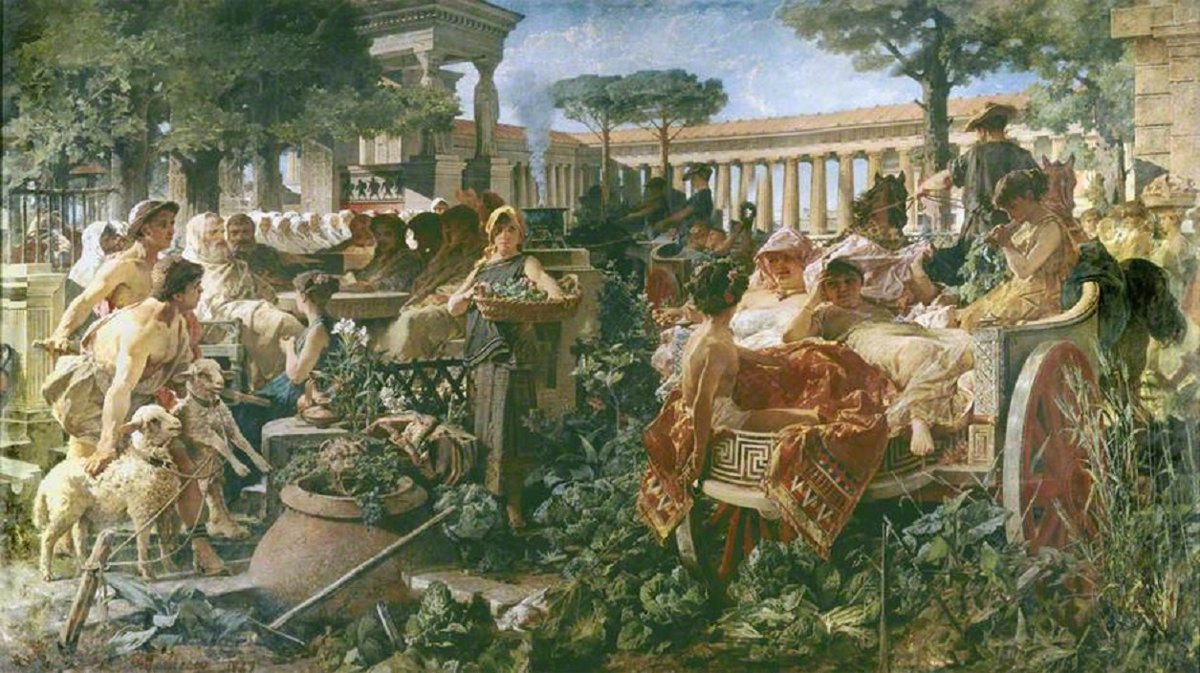 The
basis of the Pythagorean philosophy is simply stated:A Pythagorean
School"There are three kinds of men and three sorts of people that
attend the Olympic Games. The lowest class is made up of those who come
to buy and sell, the next above them are those who compete. Best of all,
however, are those who come simply to look on. The greatest
purification of all is, therefore, disinterested science, and it is the
man who devotes himself to that, the true philosopher, who has most
effectually released himself from the 'wheel of birth.'"gifThe message
of this passage is radically in conflict with modern values. We need
only consider sports and politics.
The
basis of the Pythagorean philosophy is simply stated:A Pythagorean
School"There are three kinds of men and three sorts of people that
attend the Olympic Games. The lowest class is made up of those who come
to buy and sell, the next above them are those who compete. Best of all,
however, are those who come simply to look on. The greatest
purification of all is, therefore, disinterested science, and it is the
man who devotes himself to that, the true philosopher, who has most
effectually released himself from the 'wheel of birth.'"gifThe message
of this passage is radically in conflict with modern values. We need
only consider sports and politics.

